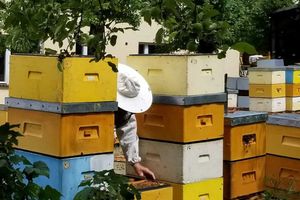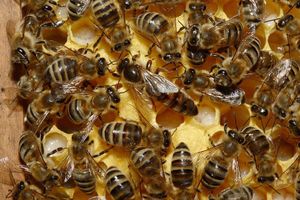Ventilation in hives from polyurethane foam is an important factor for the successful development of a healthy, strong and productive bee family. And, on the contrary, inadequate ventilation, or lack thereof leads to excessive accumulation of moisture in the hive, deterioration of the health of bees, and reduced their ability to work.
The design of the beehives allows for the use of two types of ventilation:
-
the upper (through the roof and under the roof layer);
-
the bottom (through the mesh bottom).
Upper ventilation
In this variant, the air is hovering through the bottom door entrance. When heated between the frames, warm air is rising upward, and it proceeds from excessive moisture through the openings in the roof and subassembly outside. It is worth noting that ventilation has been most effective, we recommend using the Hoffman separators. Given that the frames are installed on a cold skid, air between them circulates evenly. With the upper type of ventilation, the use of a film, foil or pillow is prohibited, as this causes a violation of the air exchange in the hive. It is precisely because of the exceptional isolation features of the polyurethane foam and the unique design of a bee colony that starts well in the spring, develops rapidly and harvest a great crop.

In the season, all vents in the roof and subassembly must be open. In winter, we leave open three vents on the back side of the submersible, in front, we close three ventilation openings and seventh, in the center, we leave half open. In the spring, we leave half open only one ventilation hole on the back side of the subdisk.
It should be noted that when using top ventilation, you should never close the venetier holes in the roof of the hive.
Lower ventilation
When using lower ventilation, pull out the drawer from the bottom of the net and close all openings in the roof and under the roof layer (subassembly). The principle of operation of the lower ventilation is based on the so-called «dome ventilation».

The diagram depicts how cold air enters the hive through the inferior bottom. In the life of bees, air is heated and rises up into carbon dioxide. Since CO2 is heavier than oxygen, it descends down the beehive wall and leaves it through the mesh bottom with excess moisture (condensation). In the summer, when bees are not in the club and thanks to the open mesh bottom and with the help of ventilation of the wings, bees bring out the hive excess moisture on their own. It is worth remembering that ventilation also occurs through a fist that needs to be expanded or even cleaned at the beginning of honey assemblies. Narrowing a pet should be necessary when feeding bees and seasoning them for winter.
Pay attention! It is not recommended to use two systems of ventilation at once, as this will turn the hive into a chimney pipe.
During warm and hot weather or during the main honey collection, when the bees evaporate the nectar, you can increase the ventilation no matter what type you choose. For this purpose, from the cases, remove the stubs and insert in their place the veneering lattices (if necessary). The holes are designed in such a way that in the open state they represent additional ventilation.








